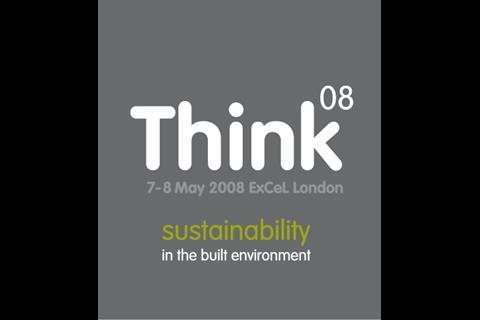US green building guru Jerry Yudelson was inspired to come up with ten reasons why clients will simply have to go green for his appearance at last week's Think event
The big picture
Now that everyone except the Clintons know who the Presidential candidates are going to be, what do you think we’ll see in the way of a changing U.S. energy policy that might favor sustainable building? Both Senators running to assume the burdens of the Oval Office have acknowledged the reality of global warming and the need to do something about it. Add to this the fact that the U.S. Congress is likely to be heavily Democratic and possibly even “veto proof,” and one can expect that legislative concern over this issue is likely to translate into a number of regulatory and financial initiatives, including expanded new national energy codes for buildings, with strong Presidential backing.Now just because something is a good idea, that doesn’t mean Congress will actually make it happen. Recently, influential New York Times columnist Thomas Friedman (“The Earth is Flat” author) took Congress to task for failing to enact legislation to extend solar and wind power tax credits now planned to end later this year. (They may still do it, but it won’t be pretty to watch it happen.) And just because something is a really bad idea, it doesn’t mean Congress won’t support it, as we’re witnessing with expanded ethanol fuel subsidies to farmers contributing to a global food crisis as good edible corn (maize for you Brits) is diverted to fuel the E85 flex-fueled, one-ton pickups and SUVs of Americans.
Green shoots
What are some of the good things happening? For one, the accelerating march of green buildings continues unabated. One measure, US Green ��ɫ����TV Council membership now stands at nearly 15,000 members (that’s companies, universities, government agencies and nonprofits, not individuals) up from 7,000 at the beginning of 2007, a huge growth in 16 months for a nonprofit that no one “has” to join. Another measure: cumulative new LEED registered projects are up 25 percent through April alone, on top of a 75 percent increase in 2007 and 50 percent in 2006.Developers of commercial speculative real estate all over the country are crawling all over each other (no animal kingdom analogies intended) to become the first, the biggest and/or the most aggressive green building advocates, for reasons that make eminently good business sense. One group I consult with wants to derive political benefits from being seen as on the side of the angels, with a “100 percent LEED” commitment. Other larger development companies have strong CEO-led initiatives for sustainability, believing that a focus on responsible property development will have strong business benefits, including the ability to hire and retain key employees. Other developers see it as a one-time opportunity to “brand” their projects in a favorable green light (recall the success of The Body Shop two decades ago with a similar “cause marketing” approach).
Think thoughts
In the light of these rapidly developing events, I have developed “Ten Testable Propositions” favoring green development that I first presented at London’s “THINK” conference earlier in May. These are testable because they’re amenable to data collection and analysis, something that’s beginning to happen. Since most of you were not in that room, I’d like you to check them out. Let me know what do you think about them.One group I consult with wants to derive political benefits from being seen as on the side of the angels, with a “100 percent LEED” commitment
1. You have to “go green”:New non-green buildings will be functionally obsolete and economically disadvantaged the day they open for business.
2. An entire real estate portfolio could become rapidly obsolete as the movement toward green development accelerates. Institutional funders won’t let this happen.
3. It’s not green if it’s not certified by an independent third-party such as BREEAM or LEED. Otherwise, there are too many compromises in the design and construction (and operations) process to guarantee any real improvement from conventional norms.
4. Sustainability matters to companies large and small. Last year about 1,200 companies used the standards of the Global Reporting Initiative to publish their sustainability reports. By 2010, every large company will be doing this.
5. Sustainability initiatives must be company-wide to be effective; CEO leadership is necessary but not sufficient to guarantee results. Senior and midlevel managers have to “buy in” for such programs to work.
Sustainability matters to companies large and small. Last year about 1,200 companies used the standards of the Global Reporting Initiative to publish their sustainability reports. By 2010, every large company will be doing this
6. Carbon is increasingly becoming the common denominator for all sustainability efforts. As a result, measuring “carbon footprint” is essential for all companies.
7. ��ɫ����TVs make a difference in attaining zero carbon growth. Not only do buildings contribute 40 to 50 percent of all carbon emissions, directly and indirectly, but also investments in them are the most cost-effective way to reduce carbon.
8. Going green gets better buildings built. The process of integrated design, construction, commissioning, occupancy and evaluation of green buildings is far better than the messy process we have now. The extra money for assessment is well spent; testing and evaluation need to be part of every building’s pedigree.
9. There is a strong and multi-faceted business case for green buildings, and it doesn’t rest on zero net carbon or energy savings “paybacks” alone. The real benefits come from making people healthier and more productive in buildings, from marketing and public relations and other sources.
10. To “go green,” one has to change the fundamental “DNA” of each organization. DNA is the code for how organisms replicate themselves, through hiring, training, empowering, motivating, communicating with, promoting, compensating (and sloughing off) their people. CEOs will begin to see the DNA transplant as a strong and necessary strategic imperative for their companies.
Now, compared to others, these are easy propositions. Now for tougher decisions, given my recent travels - whether I should have catsup, mayonnaise, mustard (English, French or German) or vinegar with my chunky fries!





























No comments yet